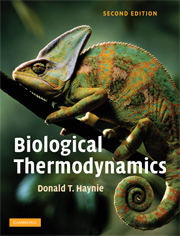Book contents
- Frontmatter
- Contents
- Preface to the second edition
- Chapter 1 Energy transformation
- Chapter 2 The First Law of Thermodynamics
- Chapter 3 The Second Law of Thermodynamics
- Chapter 4 Gibbs free energy – theory
- Chapter 5 Gibbs free energy – applications
- Chapter 6 Statistical thermodynamics
- Chapter 7 Binding equilibria
- Chapter 8 Reaction kinetics
- Chapter 9 The frontier of biological thermodynamics
- Appendices
- Glossary
- Index of names
- Subject index
- References
Chapter 2 - The First Law of Thermodynamics
Published online by Cambridge University Press: 05 June 2012
- Frontmatter
- Contents
- Preface to the second edition
- Chapter 1 Energy transformation
- Chapter 2 The First Law of Thermodynamics
- Chapter 3 The Second Law of Thermodynamics
- Chapter 4 Gibbs free energy – theory
- Chapter 5 Gibbs free energy – applications
- Chapter 6 Statistical thermodynamics
- Chapter 7 Binding equilibria
- Chapter 8 Reaction kinetics
- Chapter 9 The frontier of biological thermodynamics
- Appendices
- Glossary
- Index of names
- Subject index
- References
Summary
Introduction
To gain a good understanding of the laws of thermodynamics, it will help to develop an appreciation of the meaning of the words law and thermodynamics. Let's take a moment to think about these words before launching into a detailed discussion of how we might unpack the content of how the laws can be formulated. We are aided in this quest by the nature of science itself, which unlike ordinary prose and poetry aims to give words a more or less precise definition.
We are familiar with the concept of law from our everyday experience. Laws are rules that we are not supposed to break; they exist to protect someone's interests, possibly our own, and there may be a penalty to pay if the one who breaks a law gets caught. Such are civil and criminal laws. Physical laws are similar but different. They are similar in that they regulate something, namely how matter behaves under given circumstances. They are different in that violations are not known to have occurred, and they describe what is considered to be a basic property of nature. If a violation of a physical law should ever seem to have occurred, you will think first that the experiment has gone wrong at some stage, and second that maybe the “law” isn't a law after all.
Here's an example. Galileo, like Copernicus, believed that the orbits of the known planets were circles; the circle being the shaper of perfection and perfection being of the heavens.
- Type
- Chapter
- Information
- Biological Thermodynamics , pp. 25 - 57Publisher: Cambridge University PressPrint publication year: 2008
References
- 1
- Cited by



